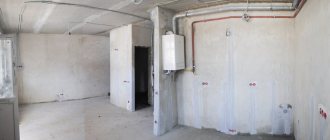If you want to change the layout of your apartment or house, you can dismantle the walls. But when carrying out this work there are certain rules. One of the main ones is that it is unacceptable to remove load-bearing structures. In addition, there should be no electrical wiring in the walls that are to be demolished. If there is one, it must first be de-energized.
Sometimes walls in apartments and houses contain water pipes. You need to be very careful with them, because you can deprive the entire house of water or heat supply. Even if you only plan to move the doorway, you need to obtain the appropriate permission.
We demolish walls during redevelopment: what can be demolished and what cannot?
Many people, especially those living in Khrushchev-era apartment buildings, try to remodel their small and uncomfortable apartments using redevelopment. But it’s one thing to do it in an individual building, and quite another to change a doorway or move a partition in a high-rise building, where almost every wall is load-bearing. All this ensures the safety of residents in combination with the entire technical design of the house.
What is redevelopment? According to the Housing Code, this concept includes all changes in the configuration of the apartment that require inclusion in the technical passport. This:
- changing the location of load-bearing walls and partitions,
- relocation of window and door openings,
- re-equipment of vestibules and dark storage rooms,
- arrangement of internal stairs,
- refurbishment of bathrooms,
- division of large rooms,
- expansion of living space due to household premises,
- glazing of a balcony or loggia,
- replacing gas stoves with electric ones,
- moving a bathroom, kitchen or toilet.
All these types of changes in the apartment relate to redevelopment and require approval from the relevant authorities.
What cannot be demolished: a load-bearing wall
Most often, redevelopment involves the demolition of interior partitions. But not everyone knows which walls can be touched and which ones cannot. Reckless demolition of structures leads to a change in the action of forces on the remaining surfaces and rooms located below. In addition, ceilings left without support may not withstand the load and collapse at any time. Since, in addition to separating different rooms, the wall elements serve as ceiling supports for all similar structural elements located above.
The main (load-bearing) walls in practice are located perpendicular to the floor beams. If it is made of concrete slabs, then their ends rest on the surface of the supporting structure. Usually these are walls between apartments and blocks, or external ones. As a rule, only partitions are equipped inside the apartment.
How to find out which wall is load-bearing?
Is it possible to determine the purpose of the wall yourself? Certainly. By its thickness or the material from which it is built. In panel-type houses, internal blocks have a thickness of up to 120 mm. Therefore, they can be considered partitions (their thickness ranges from 80-120 mm). The load-bearing surface must have a thickness of at least 140 mm. Most often, in such houses, the external walls are made with a thickness of 200 mm. In brick houses, external, load-bearing structures have a thickness of 380 mm or more, inter-apartment structures - 250 mm, and partitions - 120 or 80 mm.
The material most often used for load-bearing walls in panel houses is wall or inter-apartment blocks made of reinforced concrete with various additives to lighten the structure and increase thermal protection. Internal partitions in 90% of panel houses are made of gypsum concrete panels. In brick buildings, the main material for all walls is red and sand-lime brick, which differ in size. Gypsum concrete panels can also be used as partitions.
Of course, no one is going to demolish the outer walls, but the partitions can be removed by obtaining the appropriate permission. To accurately determine which wall is load-bearing, it is best to use BTI data - a detailed floor plan. There, all main walls are marked with thicker lines, and partitions that do not have such functions are marked with thinner lines.
What is needed for demolition?
In any case, before starting work on demolishing a particular wall and moving it, you need to consult a qualified specialist. As well as a full calculation that takes into account the distribution of loads that must be transferred from old structures to newly erected ones. In addition, you may have to change the power supply circuit. In addition, it must be borne in mind that uncoordinated demolition of the walls of the premises may prevent its sale or the preparation of donation documents, etc. But that’s not all. Such actions are considered illegal and entail fines, summonses to court, and can even lead to confiscation of the apartment.
Therefore, approval of the redevelopment project is necessary in any case. What is needed for that?
- A plan developed by the BTI service specifically for this type of redevelopment.
- Drawing up a technical report for the demolition of the wall.
- Obtaining a positive conclusion from the housing inspection at the place of registration.
***
© 2012-2020 Question-Remont.ru
Loading…
Display all materials with the tag:
- organizational matters
- construction works
Source: https://vopros-remont.ru/steny/snosim-steny-v-kvartire-pri-pereplanirovke-kakie-mozhno-trogat-a-kakie-net/
How to dismantle brick partitions
Dismantling walls and partitions made of bricks is carried out in several stages. First, you need to prepare for the work, determine a plan for its implementation, and only then can you begin the process. The dismantling plan may vary depending on whether the wall will be removed completely or partially. If the material at the base of the partition has not lost its performance characteristics, it can be reused. Only in this case is a gentle method of removing the wall used.
Attention! Removing the wall should not result in damage to the floor covering. This point should be taken into account, because the base material is quite heavy.
In the process, you can try to avoid excessive dust formation in the apartment. To do this, before breaking the partition, it must be moistened with water.
Is it necessary to legalize the redevelopment of non-load-bearing walls?
: Do I need to coordinate the redevelopment of non-load-bearing walls?
Is it necessary to coordinate the redevelopment of non-load-bearing walls, that is, partitions, in an apartment? We often receive this question from owners who decide to remodel their apartment. Let us answer right away : any redevelopment in an apartment must be approved, regardless of its scale and difficulty, including quite simple ones, like the demolition of partitions. If illegal redevelopment is detected in an apartment, inspection services have the right to issue you a fine, issue an order, and in extreme cases, go to court or confiscate your home.
What is a non-load-bearing wall (partition)? Let's go from the opposite - let's first look at what a load-bearing wall is. A load-bearing wall is a wall on which the upper structures of an apartment building rest, and the demolition of which will inevitably lead to an accident. Therefore, load-bearing walls should never be demolished. And it is possible to legalize an apartment with an opening in a load-bearing wall, provided that a project is developed with measures that will not worsen the load-bearing capacity of the house’s structures.
Non-load-bearing walls are all other walls in the house - those that do not affect the overall structure of the house. A non-load-bearing wall is most often a partition. It can be made of plasterboard, tongue-and-groove stone, brick, foam concrete and other building materials. While load-bearing walls are usually cast from reinforced concrete and their thickness is from 18 to 25 centimeters.
Which non-load-bearing walls cannot be demolished?
There are several exceptions, due to which restrictions are imposed on the dismantling of partitions. So, you can’t demolish:
- the wall between the living room and the kitchen, if the latter is equipped with a gas stove;
- a wall separating the room and the bathroom;
- walls separating the loggia or balcony from the room or kitchen.
The State Housing Inspectorate does not approve such redevelopment. And if BTI employees discover unauthorized changes, the owner will pay a fine. Also, with a high probability, he may be required to return the apartment to its original condition.
Is it possible to tear down a wall in an apartment and install a new one?
First of all, you must remember that the final decision on the demolition and construction of walls is made not by you, but by the relevant authorities. It doesn’t matter whether the wall can be demolished or not. Such procedures require redevelopment approval.
If there is reinforcement in the wall, there is a high probability that the wall is load-bearing (not only external walls are load-bearing). You need a reconstruction project that will be reviewed and, if it is safe for the building, approved. Otherwise, you will not be able to sell or exchange your apartment in the future until you return all the structures to their original form and pay the fine for unauthorized work.
Is it possible to demolish the wall between the bathroom and kitchen in Khrushchev?
Self-coordination of redevelopment: easier than it seems
If you initially doubt the advisability of further action, contact the organization that carried out the last inventory of the building. They will be able to advise you whether it is worth starting the approval procedure at all. In any case, do not carry out any work yourself; do not risk the safety of yourself or others.
Pavel Sobolev, head of the design and interior design studio Zibellino.Design, answers:
If the wall is not load-bearing, then you can “update” it. But if I were you, I would contact a specialized organization that will conduct a technical inspection of the structure. There are nuances here, for example, the floor on which your apartment is located. There are more difficulties in this regard with panel apartments.
Private practicing lawyer Victoria Suvorova (Pyatigorsk) answers:
Demolition and/or construction of new walls is a redevelopment of the apartment. You should contact the housing inspectorate at your place of residence to resolve this issue. A specialist will come to the site and give you an opinion on the possibility or impossibility of such dismantling, and will also indicate whether the wall is load-bearing or not.
How to survive a major renovation in an apartment?
We want to combine the bathroom with the toilet. Do you need approval for redevelopment?
Archkon_home Studio experts answer:
To answer the question, you need to clarify what series and year your house was built. If the partition has reinforcement, it means that it serves as a structural element of the building. All dismantling work can only be carried out if you obtain official, statutory permits. Demolition or dismantling of any load-bearing structures without the appropriate permits and inspections is strictly prohibited.
What can you do in this situation?
- Contact a commercial company that provides such services. Such organizations, as a rule, do everything on a turnkey basis and have all the necessary specialists on hand.
- Do everything yourself, starting with contacting the BTI. Then it will be possible to submit an application to the Moscow Housing Inspectorate (if we consider the case using the example of Moscow).
Further, everything depends on the scale and complexity of the redevelopment. You can read more about Moscow here.
The advantage of the first option is saving time and nerves. I would advise going along it if you have a complex redevelopment. In addition, at the initial stage, specialists will be able to give an opinion on whether the implementation of your ideas is possible at all, and will help you develop the optimal solution - one that can be accepted for approval and at the same time will suit you as a user.
Stages of redevelopment in a monolithic house
Due to the free layout of apartments in monolithic buildings, it is possible to realize the most daring ideas of designers and architects.
If the redevelopment is carried out completely, then there are several stages of its implementation:
- You can turn an ordinary kitchen into a studio. At the same time, you are allowed to change its size and location. After all, the area of the area for cooking and eating often does not meet the owner’s requirements. Therefore, the kitchen can be combined with the room.
- You can increase the area by combining the bathroom. Designers are playing with a shared bath and toilet. This measure allows you to expand the space by rationally using the wet area.
- Changes are noted in the number and area of living rooms. If they are not enough for each family member, there is the option of adding new premises. This can be achieved by dividing one bedroom into two, capturing part of the corridor or storage room.
- By taking away the corridor area, you can make the living room more spacious.
- The owner can arrange niches, dressing rooms, utility rooms. Zoning the space would also be an excellent option.
A person who destroys a load-bearing wall in his apartment will be prosecuted...
The Verkhovna Rada has amended the legislation, significantly tightening the punishment for damage to housing and communal services
It so happened historically that the architectural tastes of citizens rarely coincide with the ideas of those who create residential building projects. Especially when it comes to standard construction of the second half of the last century. The apartments in most of these buildings are cramped and have an inconvenient layout. And people often make major renovations to their homes with partial or even complete redevelopment of the interior.
Unfortunately, reconstructions are usually carried out not only without agreement with architects and utility services, but even without agreement with neighbors. As a result, self-taught builders manage to block air ducts, disrupt heating and water supply systems, demolish load-bearing walls, and add stairwells, strollers and other common areas to their apartments. Such vigorous activity sometimes leads to serious damage to the structures of residential buildings and even to their collapse.
Moreover, it is not easy to deal with would-be architects, since the most severe punishment is a fine. However, it seems that violators will soon be able to be put behind bars.
If damage is caused on an especially large scale, the death of a person or other grave consequences, the offender faces imprisonment for up to 12 years.
The Verkhovna Rada has made changes to the legislation, significantly tightening liability for damage to housing and communal services. According to the calculations of deputies, legislative changes will affect those who unauthorizedly remodel apartments, which causes premature destruction of building structures, damages ventilation systems and gas flues in residential apartment buildings, steals fire hydrants, breaks electrical switchboards and elevator equipment, stores explosive substances at home, gas cylinders, steals manhole covers, causing people to fall into sewer wells.
An article has been added to the Criminal Code of Ukraine according to which the intentional destruction or damage of housing stock, improvement facilities, heat supply, water supply and drainage, as well as their networks or components (manhole covers, gratings), if the losses exceeded 5,100 hryvnia, is punishable by a fine of 100 to 250 non-taxable minimum income of citizens (1700-4250 hryvnia) or correctional labor for up to two years. Restriction or imprisonment for up to three years is also possible.
The same actions, committed repeatedly or in a socially dangerous manner, are punishable by imprisonment for a term of three to eight years. If damage is caused on an especially large scale (17 thousand hryvnia), the death of a person or other grave consequences, the offender faces imprisonment for a term of five to twelve years.
The greatest public outcry was caused by the provision on criminal liability for illegal redevelopment. It’s no secret that in most cases, owners make major renovations in their apartments without the appropriate plans and permits. People complain about the length and cost of obtaining documents for redevelopment, as well as about the bureaucracy in this procedure. Indeed, this is a complex process that requires not only time and nerves, but also a lot of money. Although a little over a year ago the state somewhat simplified the procedure for registering redevelopment.
Let us remind you that, according to the government decree “Some issues of granting permits for preparatory and construction work,” the procedure for obtaining permits for the construction, repair and redevelopment of houses and apartments has changed significantly.
In particular, it is now possible to redevelop apartments in residential buildings and rooms in dormitories, as well as public facilities, without permission from the State Architectural and Construction Inspectorate.
But only with the preservation of load-bearing structures, without exceeding the permissible loads on floors, walls and foundations and subject to compliance with architectural and planning requirements, state building codes and local development rules.
Important clarifications
Monolithic houses are a type of residential premises built according to new technical standards.
Therefore, higher requirements are placed on:
- structural strength;
- thermal insulation;
- waterproofing;
- soundproofing.
However, such characteristics are often written down only on paper. However, the quality of housing leaves much to be desired. Therefore, many owners decide to redevelop.
Despite the fact that the ventilation shafts have become wider, it is possible to connect a more powerful system to remove air from the rooms. In order to make such changes, a project is required. When an apartment is located in a monolithic building, this is much easier to do than in a panel or brick building.
Monolithic houses create greater opportunities for redevelopment due to the absence of load-bearing walls (their function is assigned to columns, and walls can only be found in bathrooms and kitchens)
Owners can independently install heating radiators and conduct electricity from switchboards on the landing.
Between the columns there are diaphragm walls. They are necessary for fixing load-bearing structures. Their location can be found in the house design.
If you wish to carry out redevelopment, you must obtain consent from the owners of the building. The procedure is regulated by the Housing Code of the Russian Federation, as well as by the organization that manages the house.
In some cases, developers offer the client several layout options to choose from even at the time of building a house. In this case, you can save time on subsequent approval, as well as money on changing the type of living space.
Free planning is also available for standard buildings, which are made on the basis of a monolithic frame. In this case, the presence of load-bearing walls is noted. But the rooms are large, so they are divided into several parts.
If a monolithic house is built according to the standard version, it is not much different from other buildings. But making an opening in the wall in such a building is much easier. After all, the damage to the walls is minimal. Therefore, the project will be approved much faster.
To draw up a plan for remodeling a living space, you need to contact the designers. A technical inspection of the apartment is also a prerequisite.
Illegal redevelopment: responsibility of the initiator
Unauthorized removal of walls is prohibited by Russian law. If the owner carried out illegal demolition, he faces a fine of 2-2.5 thousand rubles. The final amount is determined by the amount of damage caused, if any.
Illegal demolition
Next, the owner must return the premises to its original condition. All repairs are carried out at the expense of the culprit. If the owner refuses to complete the task, the apartment may be confiscated and then sold at auction.
Important! All transformations must be carried out in accordance with the law.
What can you do without a project?
To legalize the redevelopment, you need to order the project from a company with SRO approval. Our company is a member of the SRO “MezhRegionProekt”, and for each redevelopment project we attach an extract from the register of members of our SRO. On our website you can see what redevelopment projects look like.
You can do without a project in several cases:
- your renovation is not a redevelopment
- simplified sketch approval suits you
- you have chosen a suitable standard project and there is no need to order an individual one - in practice, it suits few people
Repair is not redevelopment. If the work is not shown on the apartment plan, it is not a redevelopment. There is no need to order a project and coordinate them. This applies to all finishing work, replacement of electrical wiring, bathroom pipes, plumbing fixtures, doors and plastic windows.
In addition, you can demolish and equip built-in wardrobes without approval, as well as glaze the balcony. In practice, these works do not require any approvals. The only thing is that we advise all owners of balconies on the upper floors to glaze their balconies only after agreement with the Moscow Housing Inspectorate. This will protect against possible claims in the future if such glazing is banned. And such conversations go on, especially in winter, when ice begins to fall from the canopies above the balconies.
Moscow Government Decree No. 508-PP - clause 2 of Appendix No. 1 lists the work that requires the preparation of a redevelopment project.
Can be coordinated according to the sketch. If the redevelopment is simple, a sketch is enough to coordinate it - this is one sheet of paper that reflects the apartment plan and the planned changes. You can draw it yourself or order it from designers. For example, we have it for 5,000 ₽.
This is what the redevelopment sketch looks like, which is done in APM-1
Based on the sketch, you can agree on a redevelopment in which:
- Wet areas are not tolerated - bathroom, toilet and kitchen
- load-bearing and load-bearing walls are not affected
- When renovating a kitchen, the type of stove does not change - from gas to electric; the gas stove is not transferred
- When replacing the floor covering, the internal structure of the floor does not change
For example, according to the sketch, you can divide a large studio into several rooms. But if the house is old, with wooden floors, you will have to order a project and contact the author of the house project.
What redevelopments do not require approval in 2021
How to understand whether you can do redevelopment or not
If you cannot figure out whether the work you want to do is allowed or not and how to properly coordinate it, ask the specialists. During the consultation, the necessary questions will be asked and the success of the agreement will be assessed. It is faster and more reliable than searching for information in different sources. Let's tell you how this happens in our company.
At APM-1, consultation is free. You can make an appointment and come to an appointment, you can write to us on WhatsApp or by mail, or call the manager +7 (495) 181-13-09. We will definitely answer your questions. Then the engineer will come to your apartment, inspect it and check for any pitfalls. Extensive experience in working with the Moscow Housing Inspectorate allows us to make accurate forecasts and take into account what inspectors do or don’t let in in practice.
If we understand that some work cannot be completed, we will definitely tell you about it and offer options on how to solve your problem differently.
Leave a request for a free consultation on apartment redevelopment
Zamyatin Dmitry Alekseevich
Zamyatin Dmitry Alekseevich
General Director of LLC "APM-1" Design workshop PEREPLAN.
Education: Higher technical (Master's degree from Moscow State University of Civil Engineering)
Specialization Coordination of redevelopment of commercial and residential real estate in Moscow and St. Petersburg
General rules of the process
Dismantling partitions can lead to structural problems. When knocking out a large section of the wall, there is a risk of the ceiling collapsing, which will lead to irreparable consequences.
It is recommended to follow some rules when carrying out redevelopment or demolition of interior partitions:
- The partition is dismantled in small sections, subject to safety standards.
- If there is a doorway, dismantling the structure begins from this area.
- A sledgehammer is often used as the most suitable, simple tool.
- Disassembly must be done from the ceiling down.
A number of techniques that can help to carry out proper dismantling:
- During the dismantling process, you should visually determine the size of the pieces being removed and, if necessary, break them into smaller ones.
- Dismantling concrete partitions will create some difficulties. Therefore, it is better to use a special power tool. It could be Bulgarian. This generates a lot of dust, and therefore all manipulations are carried out with open doors and windows.
- Dismantling with a sledgehammer is considered a quick but energy-consuming method.
- Disassembly can be done with a hammer drill or drill. More through holes need to be drilled. Then all that remains is to use a sledgehammer to knock out the elements along the marked perimeter.
To reduce dust formation, it is recommended to spray partitions made of concrete and brick with water. Also, to collect dust and create an obstacle when leaving the room, a wet sheet is hung.
What redevelopments can be done without a project?
The project is needed in most cases. But sometimes you can do without it, namely:
- Not redevelopment, but cosmetic repairs, for example - you have wallpapering, installing air conditioning, windows, replacing sockets or plumbing equipment in the toilet.
- A sketch is drawn up - approval according to this scheme is considered a simplified version. It is enough to order a technical plan from the BTI and apply the planned changes to it. For example, laying a door block or demolishing plasterboard partitions in a Khrushchev building.
- Selecting one of the standard projects in the catalog from the author of the house (JSC MNIITEP). Instead of a project, it is enough to provide a link to the redevelopment option you like, and the administration will approve it. But you cannot deviate from the standard project - otherwise the commission will not accept the work.
Before agreeing on redevelopment without a project, it is better to consult with specialists or a lawyer.











